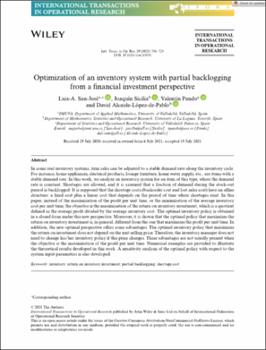Optimization of an inventory system with partial backlogging from a financial investment perspective
Fecha
2022Resumen
In some real inventory systems, item sales can be adjusted to a stable demand rate along the inventory cycle. For instance, home appliances, electrical products, lounge furniture, home water supply, etc., are items with a stable demand rate. In this work, we analyze an inventory system for an item of this type, where the demand rate is constant. Shortages are allowed, and it is assumed that a fraction of demand during the stock-out period is backlogged. It is supposed that the shortage costs (backorder cost and lost sales cost) have an affine structure: a fixed cost plus a linear cost that depends on the period of time where shortages exist. In this paper, instead of the maximization of the profit per unit time, or the minimization of the average inventory cost per unit time, the objective is the maximization of the return on inventory investment, which is a quotient defined as the average profit divided by the average inventory cost. The optimal inventory policy is obtained in a closed form under this new perspective. Moreover, it is shown that the optimal policy that maximizes the return on inventory investment is, in general, different from the one that maximizes the profit per unit time. In addition, the new optimal perspective offers some advantages. The optimal inventory policy that maximizes the return on investment does not depend on the unit selling price. Therefore, the inventory manager does not need to change his/her inventory policy if this price changes. These advantages are not usually present when the objective is the maximization of the profit per unit time. Numerical examples are provided to illustrate the theoretical results developed in this work. A sensitivity analysis of the optimal policy with respect to the system input parameters is also developed.






